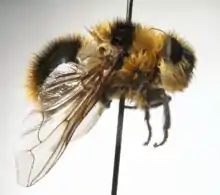Cephenemyia trompe
Cephenemyia trompe,[1] also known as the reindeer nose botfly, is a species of botfly first described by Adolph Modéer in 1786. It belongs to the deer botflygenus Cephenemyia.[1][2][3] This fly is parasitic on reindeer. It is one of two Cephenemyia species found only in Scandinavia.[1][3]
| Reindeer nose botfly | |
|---|---|
 | |
| Scientific classification | |
| Kingdom: | Animalia |
| Phylum: | Arthropoda |
| Class: | Insecta |
| Order: | Diptera |
| Family: | Oestridae |
| Genus: | Cephenemyia |
| Species: | C. trompe |
| Binomial name | |
| Cephenemyia trompe (Modeer, 1786) | |
| Synonyms | |
|
Oestrus trompe Modeer, 1786 | |
The larvae of Cephenemyia trompe infect the nose area of reindeer.[4] The adult is active during the Arctic summer, being able to fly very fast and having developed olfactory abilities to find reindeer from long distances.[5] Its activity, however, is inhibited by strong winds, low temperatures and rain or snow.[6] This species has a very short pupariation time compared to other reindeer botfly species.[7]
See also
- Botfly
- Hypoderma tarandi, the reindeer warble fly, another parasitic reindeer fly
References
- Bisby F.A.; Roskov Y.R.; Orrell T.M.; Nicolson D.; Paglinawan L.E.; Bailly N.; Kirk P.M.; Bourgoin T.; Baillargeon G.; Ouvrard D. (red.) (2011). "Species 2000 & ITIS Catalogue of Life: 2011 Annual Checklist". Species 2000: Reading, UK. Retrieved 24 September 2012.
- Systema Dipterorum. Pape T. & Thompson F.C. (eds), 2011-01-06
- Dyntaxa Cephenemyia trompe
- Epizootiology of the reindeer nose bot fly, Cephenemyia trompe (Modeer) (Diptera: Oestridae), in reindeer, Rangifer tarandus (L.), in Norway
- The olfactory response of the reindeer nose bot fly,Cephenemyia trompe (Oestridae), to components from interdigital pheromone gland and urine from the host reindeer, Rangifer tarandus
- Anderson, JR; Nilssen, AC (1996). "Trapping oestrid parasites of reindeer: the response of Cephenemyia trompe and Hypoderma tarandi to baited traps". Med Vet Entomol. 10 (4): 337–46. doi:10.1111/j.1365-2915.1996.tb00754.x. PMID 8994135.
- Douglas D. Colwell, Martin J. R. Hall, Philip J. Scholl & A. C. Nielsen eds. The Oestrid Flies: Biology, Host-parasite Relationships, Impact and Management, p. 126
External links
 Media related to Cephenemyia trompe at Wikimedia Commons
Media related to Cephenemyia trompe at Wikimedia Commons- EOL Cephenemyia trompe Reindeer Nose Bot Fly
- The two reindeer parasites, Hypoderma tarandi and Cephenemyia trompe (Oestridae)
- Factors affecting size, longevity and fecundity in the reindeer oestrid flies Hypoderma tarandi (L.) and Cephenemyia trompe (Modeer)
This article is issued from Wikipedia. The text is licensed under Creative Commons - Attribution - Sharealike. Additional terms may apply for the media files.